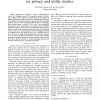1816 search results - page 62 / 364 » Trace oblivious computation |
LISP
2008
14 years 11 months ago
2008
Abstract. Tracing computations is a widely used methodology for program debugging. Lazy languages, however, pose new demands on tracing techniques because following the actual trac...
PLDI
2010
ACM
15 years 4 months ago
2010
ACM
Self-adjusting computation provides an evaluation model where computations can respond automatically to modifications to their data by using a mechanism for propagating modifica...
IPPS
2008
IEEE
15 years 5 months ago
2008
IEEE
We propose a new fault localization technique for software bugs in large-scale computing systems. Our technique always collects per-process function call traces of a target system...
HAID
2009
Springer
15 years 3 months ago
2009
Springer
A very common task in medical applications and motor-skill training is to trace a path. However, when designing a haptically guided interface, designers need to consider the choice...
101
click to vote
COMSNETS
2012
13 years 6 months ago
2012
—Researchers choosing to share wireless-network traces with colleagues must first anonymize sensitive information, trading off the removal of information in the interest of iden...


